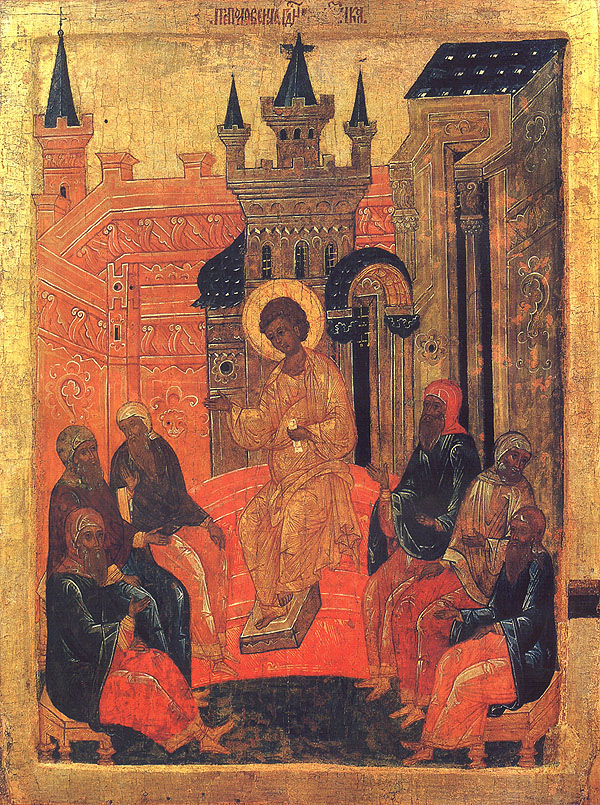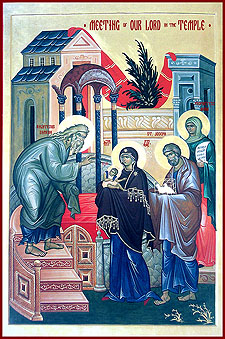“The most solemn festival of the Apostles is come to the Church of Christ, bringing us salvation. Therefore, let us mystically clap our hands and cry out to them: Rejoice, ye luminaries for those in darkness; ye are rays of the Sun. Rejoice, Peter and Paul, ye indestructible foundations of the divine doctrines, ye friends of Christ, ye precious vessels. Be ye present invisibly in our midst, and deem us worthy of immaterial gifts, as we acclaim your feast with songs.” +Doxasticon of the Feast at Orthros, Tone Six
On June 29 in the Holy Orthodox Church, we commemorate the holy, glorious, all-laudable and foremost of the Apostles, Peter and Paul. This is the patronal feast of the Patriarchate of Antioch and All the East.
During the hierarchical liturgy on the Feast of Ss. Peter and Paul in 2014, His Beatitude Patriarch John X of Antioch and All the East addressed a gathering of thousands of Antiochian Orthodox Christians from around the world at the University of Balamand in Lebanon. His words are more relevant than ever today.
Today the church of Antioch in the homeland embraces apostolically the Antiochian church of overseas. Today our sons in North America, Canada, Mexico, Brazil, Argentina, Chile, Australia, France, Germany, England, Scandinavia, Switzerland, Austria, all Europe and the four corners of the world embrace their mother church that baptized them and their ancestors and anointed their lives with the name of Christ so they anoint her by their love and giving, by their longing and sacrifice in standing up to its concerns….
Faith is a “deposit.” This is what our liturgical books say when they talk about “preserving the deposit.” This allows us to say that the faith of our ancestors has been preserved as a deposit. It reached us and we received it despite the atrocities of history. And this is our message today: to keep the faith despite the most difficult situations. Keeping our faith means to always be one hand and one body where all the geographical distances melt and the logic of solidarity and being there for the needy prevails….
Our Antiochian Orthodox Church is a vineyard in the true sense of the word. The vineyard spreads its branches away and the branches grow in a new land and flourish new parishes and dioceses overseas, in the two Americas, Australia and Europe. These dioceses might have a special situation because they are planted in a faraway land but they stem from the Antiochian root that provided them with priests, pastors and experience….
“So that they may be one.” These are your words O Lord; so grant us to act according to them, to fulfill them and to raise our thanks to You with Your Father and Your Holy Spirit, Glory be to Thee forever, Amen.”
Saints Peter and Paul are beloved by Antiochian Christians around the world. Church Tradition teaches that the chiefs of the apostles both died for their Lord on this day in 64 A.D.
Saint Peter was a fisherman and at first was called Simon; but the Lord was pleased to call him Cephas or Peter. “And when Jesus beheld him, He said, ‘Thou art Simon the son of Jonah; thou shalt be called Cephas,’ which is by interpretation, a rock” (John 1:42). He was the first of the disciples to clearly express faith in the Lord Jesus saying: “Thou art the Christ, the Son of the living God” (Matthew 16:16).
Paul (born “Saul”) studied under the well-known Jewish teacher and scholar Gamaliel. He was a highly educated Pharisee and a determined persecutor of Christianity. Miraculously, Paul was converted to the Christian Faith by the Lord Himself, Who appeared to him on the road to Damascus. “Suddenly, a light from heaven flashed about him. And Saul fell to the ground and heard a voice saying to him, “Saul, Saul, why do you persecute Me?” And he said, “Who art Thou, Lord?” And He said, “I am Jesus, Whom you are persecuting” (Acts 9:3-5). Saul was termporariy blinded after this encounter, but regained his sight after he was baptized by the Apostle Ananias.
Many years! Mabrouk! Prayers for all of the parishes and faithful who celebrate their name day today.
Troparion — Tone 4
O first-enthroned of the Apostles, and teachers of the universe, intercede with the Master of all to grant peace to the world, and to our souls great mercy.
Kontakion — Tone 2
(The original melody)
O Lord, You have taken to Yourself the steadfast and divinely-inspired heralds, the leaders of Your Apostles, for the enjoyment of Your good things and for their rest; for You have accepted their labors and their deaths as above all burnt offerings, for You alone know the hearts of men.
Kontakion — Tone 2
Today Christ the Rock glorifies with highest honor the rock of Faith and leader of the Apostles, together with Paul and the company of the Twelve, whose memory we celebrate with eagerness of faith, giving glory to Him Who glorified them!









